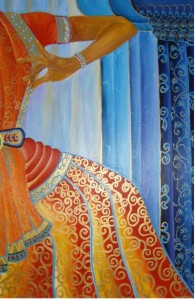By Alim Hosein
Damian Moore is a young artist who is now trying to make a name for himself. He is a graduate of the Fine Arts programme of the University of Guyana (2007) and was recently given the opportunity of having his work exhibited nationally for the first time.
The chance to do so came from the Centre of Brazilian Studies, which has been in the forefront of promoting Guyanese art over the years. For this year so far, the centre has mounted four exhibitions of Guyanese art – by the Guyana Women Artists Association, Terence Roberts, the Association of Guyanese artists and most recently, Damian Moore’s work. This last exhibition is, however, different from the others.

This is a commendable step, since it allows artists who are younger in their ages and in their careers to enjoy the use of a small, friendly exhibition space, with a minimum outlay of expense on their part and with good support from the centre’s administration, to introduce their art to the public. This fills a crucial gap in the business of art promotion and therefore creation in this country. Not all new and young artists can immediately match the high standards and quantity of production necessary for an exhibition at, say, Castellani House, and there are few other spaces available for them to use as exhibition halls.
Moore fits the centre’s aim very well. He is now trying to make his name public, and he has the ambition to develop his work in particular areas. His work falls into two groups – paintings and textiles. However, it is clear that his art lies somewhere in between fine art (painting) and fashion design. The main attractions in his exhibition are his paintings, but it is immediately clear that two-dimensional design is where his interest lies.
In five larger paintings, which are all entitled Dance (Dance 1-5) he flattens out images of dancing, sari-clad women into two-dimensional pictures. Attention is paid to the design work on the saris, but also, the curves of the figure and the folds of the cloth are all simplified and highlighted to create a pattern, which makes up the painting. The figure seems to be only incidental in these paintings. In Dance 1, he focuses on the area of the dancer’s feet, in Dance 2 and Dance 5, the area is her hips. The interest is on the patterns of cloth and shape in these areas. His other small paintings such as Indian Designs and Henna Designs are actually depictions of isolated motifs. Any one of these could be replicated to form design work on cloth or other fabrics.
He uses some very catchy colour combinations in these paintings – blues, reds, greens oranges along with metallic gold to highlight motifs. This, along with the subject matter, gives the works a luxuriant, exotic feel.
In these paintings, Moore is also exploring an aspect of his ancestry. Of mixed heritage, he has fallen in love with the East Indian designs and motifs and began exploring them in his work some time ago.
Of the two arts on display – painting and fabric design, Moore prefers the latter. It is noteworthy, then, that the paintings dominate the exhibition. This is partly because of the way in which the exhibition was arranged: paintings greeting visitors as soon as they step in; while the fabrics were off to one side. They were not well-separated from each other so as to show the designs to full advantage – and also because it is really difficult for decorated raw material to really stand out nowadays, unless the artist does something innovative in colour, technique or design.
Textile designing in Guyana (as distinct from clothes design, which is taking off because of the recent work of the designers such as Sonia Noel and others) has suffered from a sameness over the years as the same techniques – tie-dye, discharge, print, fabric painting etc – are being utilized in much the same ways. Moore uses all of these techniques in his work, and for some adventurousness, he adds some beadwork to his fabrics. However, he has not as yet managed to come up with a distinctive artistry in textile designing.
Two other artists – Sandra King and Angelina Yearwood – were part of the exhibition. King is a retired Art teacher who has encouraged Moore in his work, and Yearwood is a UG Fine Arts graduate who works in Linden. Both displayed textile design pieces.
The work of these women is similar. Both created some beautiful designs on fabric using various techniques such as tie-dyeing and hand painting. In many cases the design work is placed along the edges or borders of the fabric, and in other cases the artistry of the work lies in the overall tie-dye design or in other forms of design on the fabric. King also does hand paintings on t-shirts and on throw cushions.
Moore’s preference is for fabric and garment design, and he plans to break into the currently-hot fashion industry. He has benefited for some exposure to textile designing through trips, which the UG Fine Arts department had made to Tougaloo College in Mississippi in 2004 and 2005, and he also has had some training in garment construction in Trinidad. Given his age, interest and background, he has the opportunity to make good in this field. But as a person who has benefited from serious training in art, he also has the opportunity to change the sameness in fabric decoration mentioned earlier. Moreover, these two opportunities are not necessarily separate.



